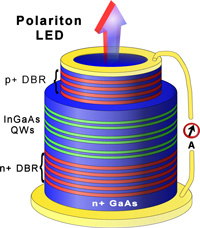
| Home | About Us | Contribute | Bookstore | Advertising | Subscribe for Free NOW! |
| News Archive | Features | Events | Recruitment | Directory |
| FREE subscription |
| Subscribe for free to receive each issue of Semiconductor Today magazine and weekly news brief. |
News
15 May 2008
Electric-powered exciton-polariton light
Researchers at the University of Crete have managed to create a light-emitting exciton-polariton device on a gallium arsenide (GaAs) substrate using electrical pumping [Tsintzos et al, Nature, p.372, 15 May 2008]. Previous reports of polariton emission have been in optically pumped studies. While the operating temperatures of the electrically pumped devices reach up to a slightly chilly 235K (-38ºC), this is much higher than the usual temperatures (10-100K) used to manipulate exciton-polaritons in GaAs, bringing into view room-temperature (~300K) devices.
The microcavity LED structure was grown using molecular beam epitaxy (MBE), and sandwiches three pairs of InGaAs quantum wells between two GaAs/AlAs distributed Bragg reflectors (DBRs). The ohmic contact to the n-type material is gold-germanium alloy, and to the p-type material a titanium-platinum ring contact is made. The microcavity is five half-wavelengths in length. Measurements were made around the emission energies of 1.33-1.37eV, representing near-infrared wavelengths of around 900-930nm.
 Electroluminescence was also measured as a function of angle to further study the polariton relaxation dynamics. This revealed a bottleneck or suppressed relaxation of the lower polariton branch, as commonly seen in such systems.
Electroluminescence was also measured as a function of angle to further study the polariton relaxation dynamics. This revealed a bottleneck or suppressed relaxation of the lower polariton branch, as commonly seen in such systems.
Picture: Schematic of polariton microcavity LED.
Some exciton-polariton studies (optical pumping) have been carried out at room temperature in a bulk gallium nitride (GaN) microcavity [Christopoulos et al, App. Phys. Lett., vol.98, p.126405, 2007]. However, a GaAs-based system has the attraction of a mature growth technology. Also, the light emitted by these systems is very different: near-infrared for GaAs and visible (~3.4eV, 360nm wavelength) for GaN.
Exciton-polariton states offer a wide range of opportunities for developing new devices that emit laser light more easily (i.e. with lower thresholds, maybe up to two orders of magnitude lower). Some of the effects that may lead to this include stimulated scattering, parametric amplification, Bose-Einstein condensation and superfluidity.
Exciton-polaritons are states resulting from strong coupling of electron-hole bound states, or excitons, with photons. Near where the wavelength and frequency properties of the exciton and photon states would cross without interaction, the coupling combines the states into an ‘upper’ and ‘lower’ branch that do not cross (anti-crossing). Continuing away from this point, the lower branch becomes effectively more photonic at long wavelengths and more excitonic at short wavelengths, while the situation is reversed for the upper branch [for more details and a diagram, see Cooke, Semiconductor Today, p.42, April 2007]. Other polaritons exist involving other excitations such as phonons and surface plasmons strongly coupled to photons.
Further studies of the University of Crete device suggest that “the present injection scheme is unlikely to yield a polariton laser, owing to inefficient polariton relaxation down the polariton branch”. However, the research could lead to devices with “dramatic enhancement” of spontaneous emission, even compared with resonant-cavity LEDs (RCLEDs). Using this, future polariton-based emitters could have unprecedented quantum efficiencies with ultra-low power consumption, the researchers reckon.
Further, in another configuration, the stimulated emission needed for lasing is encouraged by the extremely low density of states of the polaritons (four orders of magnitude compared with normal laser diodes), potentially lowering lasing thresholds by an order of magnitude.Search: LEDs GaAs MBE InGaAs quantum wells GaN
Visit: www.nature.com
Visit: www.materials.uoc.gr/materials_en
Visit: www.iesl.forth.gr
The author Mike Cooke is a freelance technology journalist who has worked in the semiconductor and advanced technology sectors since 1997.